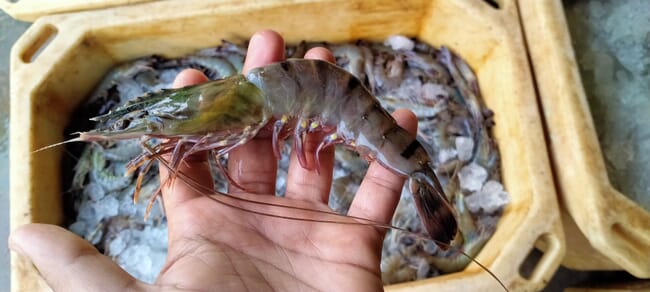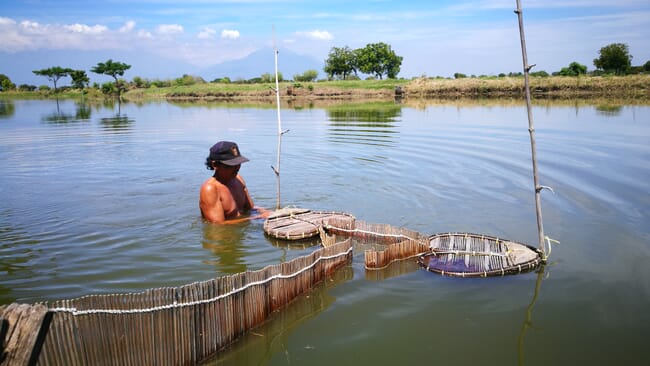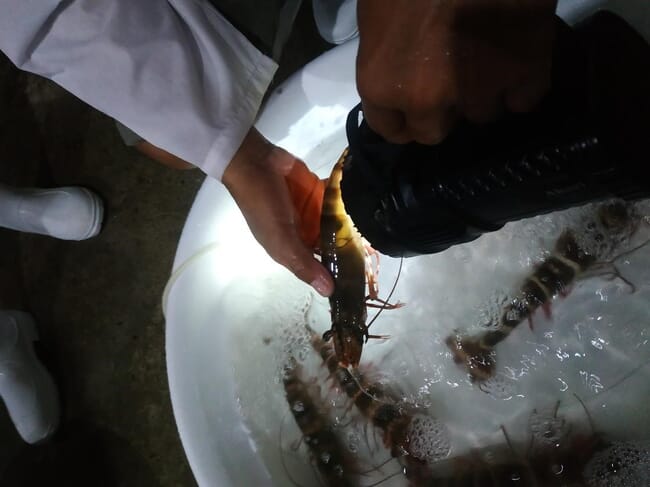
Speaking at last week’s Global Shrimp Forum, McIntosh – who is senior vice president of CP Foods, and one of the world’s pre-eminent shrimp farming experts – gave an enlightening presentation on the fate of the monodon sector and why it is set to rebound after two decades of decline.
Changing of the guards
McIntosh explained that shrimp farming started in earnest in Asia around 1985, with black tiger – then sourced from wild broodstock and wild PLs – as the number one species. However, it began to be replaced by imported whiteleg shrimp (Litopenaeus vannamei) around the turn of the millennium, due to poor monodon genetics, which were leading to a reduction in growth rates and sizes.
“By 2002 black tiger lost money for everyone, so there had to be a change. The change was that we brought in the white shrimp as it was already domesticated… if we had domesticated the black tiger the white shrimp would never have come over, but we did not and so the white shrimp filled the gap,” McIntosh explained.
In the meantime some companies, including CP (in 2003) and Moana (in 2001), began to look into domesticating black tiger.
“Taming the tiger was a lot harder than anyone anticipated. The white shrimp – you bring it in and then it’s almost ready to go and select. The black tiger takes eight generations to get selectable,” he noted. "But at the same time we continued to work with black tiger and see what we could do,” he added.
In order to establish an SPF programme, CP had to ensure clean stocks, bringing in as much genetic variation as possible from around the range of the species. Once domesticated, after eight or nine years, they were able to start a selection programme at their breeding centre in Thailand. Now on its 14th generation, McIntosh was able to chart how survival rates have risen from around 30 percent to 85 percent. And, as performance improves, so does the uptake by farmers.

“With this domesticated vannamei we’ve reversed the downward trend,” he noted, explaining that global production of the species had fallen from 700,000 tonnes in 2004, to 300,000 tonnes in 2018, before rising to 500-600,000 tonnes today.
The main countries to have capitalised on the new domesticated strains of monodon include China, Thailand, Vietnam, India, Malaysia, Bangladesh and Madagascar, and McIntosh noted a meteoric 42 percent growth rate in the species between 2019 and 2021.
Pros and cons of black tiger shrimp
The key advantages of black tiger, according to McIntosh, is that the species is tolerant to both EMS/AHPND and EHP.
“In Vietnam, or India, or Thailand when [white] shrimp are dying and not doing well, you put black tiger in they seem to do well, so that’s a huge impetus to put black tiger in. They require a lower capital investment – I call black tiger the poor man’s shrimp – you don’t need the liners, heavy aeration, you don’t need all the upgrades that you need with white shrimp, so more farmers can do this. And it has a very good market value,” he said.

© Ernesto Jack Morales
The disadvantages of black tigers include the comparatively low yields and lower growth rates, although McIntosh believes that these but might exceed white shrimp in 10 years as the selection programme catches up with the vannamei.
“If we go up 10 years we’ll probably see the monodon catch and exceed white shrimp,” he predicted.
Case studies
McIntosh cited a number of CP’s farms in Thailand where black tiger shrimp had performed particularly well – with individual crops reaching as much as 45 g in 115 days.
“Stocking densities are lower than white shrimp, but survival rates are good, FCRs can be very good. Yields? It’s not white shrimp but there’s nothing wrong with 12 tonnes per ha,” he said.
“The performance is much better today even than it was in the best days of black tiger in the late 1980s, early 1990s,” he added.
Meanwhile, McIntosh outlined how more and more ponds in China, in which white shrimp crops had failed are now being successfully stocked with black tiger – with performances on a par with black tigers in Thailand and prices better than for white shrimp.

He related how one of CP’s customers in China arrived in his office with a box of the country’s finest green tea and told him that “this is the best thing that’s happened to Chinese aquaculture in the last 10 years”.
New strategies for growing tiger shrimp
McIntosh then outlined a number of new production techniques. These included a polyculture system in which white shrimp are added to black tiger ponds 6-7 weeks after the latter have been stocked.
“You have to head start the black tiger or the vannamei will kill them,” McIntosh explained.
Another involves the rotational culture of black tiger with white shrimp to reduce pathogen loads.
“What we have found in Thailand is that we have three cycles – there’s a clean and a dry before the first cycle, which is successful for white shrimp, but the second white shrimp cycle is a failure, the third white shrimp cycle is a failure before it’s cleaned up again. But if we put black tiger instead of vannamei in the second cycle, we can get a successful second cycle, it reduces the pathogen load and the third cycle can again be successful with white shrimp,” he explained.
Black tiger in the Americas
McIntosh also raised the intriguing prospect of farming black tiger – a species native to Asia – in the Americas.
“Black tiger in big ponds at low densities do fantastic. Asia learned take the white shrimp [which is native to South America] at high densities and did a good job there. If the Americans had taken black tiger and put it in their 10 ha ponds at three or four per square metre they wouldn’t have had many of the problems that they have, but they always thought black tiger was an exotic species and they didn’t want it,” he reflects.
Now that black tiger populations have established themselves in the wild across a swathe of the Americas – from northeastern Brazil, where there is a big enough population to support a commercial fishery, to North Carolina – McIntosh wonders if regulations for farming them might change before too long.
“I’ve tested this black tiger, it’s clean, it’s SPF black tiger in the Americas. If the regulators just left somebody alone to domesticate this American tiger, I think this would be very good for some of the failed big ponds in the Americas. It’s just a matter of time,” he predicted. “Black tiger does very well in semi-intensive ponds, so for me black tiger is the perfect match,” he added.

While McIntosh spent considerable time – and CP spent considerable money – to improve the prospects of the monodon sector, he feels that their efforts haven’t met with their just rewards.
“I spent 12 years on monodon without earning a dime and one year later people have taken it and are reproducing it... I think we have to get smart relative to allowing broodstock companies who are investing large money to maintain some of their intellectual property and benefit everybody. Because, if there is no benefit there’s no need to continue the investment,” he argued.
Conclusions
While McIntosh doesn’t believe black tiger will ever exceed white shrimp production levels globally, he does see the species having a bright future in a range of geographies now that the genetics have been improved.
“Today the domesticated black tiger is as easy to run in a pond or in a hatchery as the vannamei, which was not the case in 2001-2001. So it will have its niche and it will continue to grow. Especially if we continue to have issues with the white shrimp in Asia, because the black tiger does seem to have some attributes which allow it to survive when the white shrimp is not,” he concluded.








